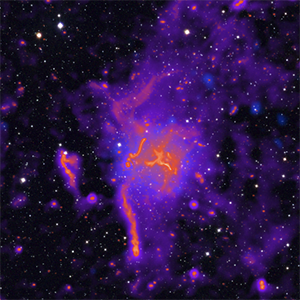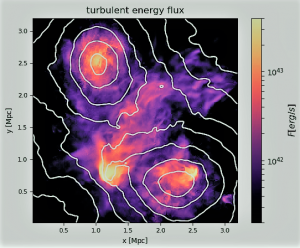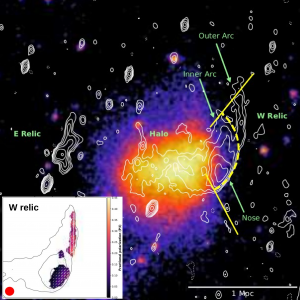
A. Composite image of galaxy cluster Abell 2255. X-ray data (blue) from ROSAT show hot gas between the galaxies; radio data (orange and purple) from LOFAR show several cluster radio galaxies, the radio relics and the pervasive halo emission which permeates the entire cluster. Background optical image taken with the SDSS.
Galaxy clusters are the most massive structures in the Universe. They grow at the intersection of cosmic filaments through a sequence of mergers. During these energetic events kinetic energy is dissipated in the heating and the dynamics of the hot intra-cluster medium and in non-thermal components, particles and magnetic fields. Non-thermal components generate emissions at radio frequencies and potentially up to gamma rays. We study these phenomena with the largest existing radio facilities, also developing theoretical models.
Staff: G. Bernardi, A. Botteon, G. Brunetti, R. Cassano, F. de Gasperin, C. Gheller, C. Stuardi, T. Venturi
Collaborators: A. Benati, A. Bonafede, M. Brienza, L. Bruno, V. Cuciti, D. Dallacasa, E. De Rubeis, L. Feretti, G. Giovannini, M. Gitti, T. Pasini, C. Riseley, K. Srikanth, F. Vazza
Diffuse radio emission
Part of the galaxy clusters show cluster-scale synchrotron radio emission in the form of giant radio halos, radio relics and mini-halos. In some cases synchrotron radiation is also observed form gigantic bridges connecting pairs of massive clusters. Halos and relics are found in merging clusters and are thought to be powered by the shocks and turbulence generated by cluster dynamics. We use radio observations, together with their follow-up in the X-rays and optical band, to study the connection of cluster-scale radio sources with cluster dynamics and with the properties of the intra-cluster medium. Our group is leading large programs to address the properties of cluster-scale radio sources, as well as their formation and evolution across cosmic epochs. Among other facilities we exploit the LOFAR and MeerKAT telescopes, which are currently stepping into uncharted observational territories. Finally, we study the interaction between the intra-cluster medium and the cluster radio galaxies, including the head-tail and Brightest group and Cluster Galaxies (BCG).
Particle acceleration and plasma physics

B. Image of the kinetic turbulent energy flux integrated along the line of sight in a pair of interacting clusters from high-resolution MHD cosmological simulations. Contours refer to gas projected matter density
The intra-cluster medium is a turbulent and weakly collisional plasma on which instabilities play an important role. Understanding the physics of this plasma is crucial to address how turbulence and shocks are dissipated, particles are accelerated and magnetic fields are amplified. It serves also to understand the mechanisms of transport/mixing of particles and fields in the intra-cluster medium. Diffuse radio emission from clusters is a fundamental probe of the physics being generated by the complex mechanisms that transfer energy from Mpc to small scales, involving shocks and turbulence. We use theoretical models and advanced numerical simulations (cosmological, MHD, kinetic) to study turbulence, shocks and non-thermal plasma in the intra-cluster medium and to model the origin and evolution of diffuse radio emission in clusters, bridges and cosmic filaments. Our models also produce expectations for high-energy emissions from clusters, allowing us to provide useful parameters for the design of future instruments.
Magnetic fields

C. Image of the X-band emission of the RXC J1314 cluster with radio contours at 1.4 GHz overlaid. In the bottom-left panel: the Western relic is shown where polarization is detected, with the map of the Rotation Measure in color and radio contours in black.
Magnetic fields in the intra-cluster medium are weak and hence dynamically irrelevant (energy density ~1/100 of the thermal one). Yet they are important players, as they drive thermal conduction and govern particle acceleration/transport. The origin of the magnetic fields in clusters is still poorly understood. They could either result from the amplification of a primordial seed or be injected by AGN within the clusters. Magnetic fields are better studied using polarimetric observations of sources located within/behind the cluster. We use the most advanced techniques, such as the Faraday Rotation measure synthesis, and observations from front-line radio instruments to constrain the properties of magnetic fields in clusters and their surroundings, and understand their origin. We complement observations with advanced simulations that allow us to model the magnetic field amplification by turbulent dynamo and to connect the magnetic field properties with the physical parameters of the intra-cluster medium.
Credits
Figure A: Botteon et al. 2022, Science Advances, 8, eabq7623, “Magnetic fields and relativistic electrons fill entire galaxy cluster”, adapted from Figure 2. DOI: 10.1126/sciadv.abq7623
Figure B: Brunetti & Vazza 2020, Phys. Rev. Lett. 124, id.051101, “Second-order Fermi Reacceleration Mechanisms and Large-Scale Synchrotron Radio Emission in Intracluster Bridges”, Figure 1. DOI: 10.1103/PhysRevLett.124.051101
Figure C: Stuardi et al. 2019, MNRAS 489, 3905, “Particle re-acceleration and Faraday-complex structures in the RXC J1314.4-2515 galaxy cluster”, adapted from Figure 2 and 10. DOI: 10.1093/mnras/stz2408
